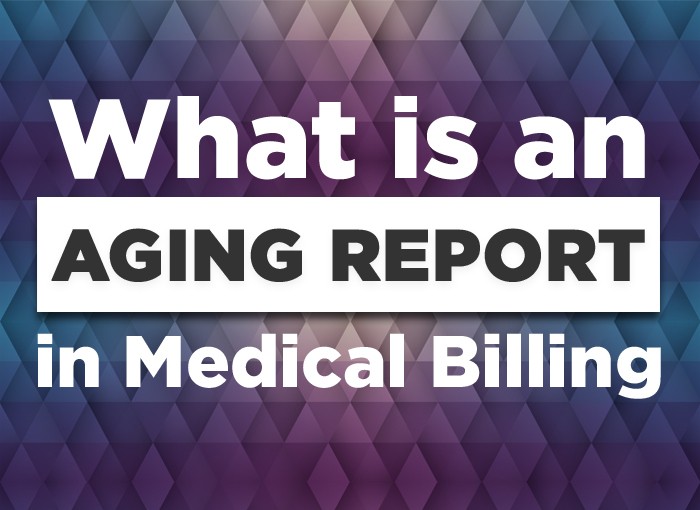What is an Aging Report in Medical Billing
Hospitals are required to review revenue reports every month. These reports help a medical institution to assess its revenue cycle. The purpose is to understand the revenue generation pattern by comparing the current reports to previous reports. If the hospital finds out that the current report is showing poor revenue generation then it needs to change its revenue management strategy.
The results of the A/R aging report are measured using certain benchmarks to identify the medical institution’s financial health. The benchmarks are as follows:
- Accounts received in 35 or fewer days represent good financial health
- Accounts received in 35-50 days represent average financial health
- Accounts received in 50 or more days represent poor financial health
To achieve good financial health, the hospital must perform A/R follow-up without any interruption or delay. Following on the pending accounts and reviewing the denied claims is the only way to generate high revenue while ensuring a better aging report.
Aging Report Format/Structure
There is no specific format or structure for an aging report. However, what’s similar in every aging report is the listing of clients, current A/R, total A/R, and division of A/R days. The division of A/R days tends to vary across hospitals. One hospital may show A/R days up to 90 days whereas other hospitals may show A/R days up to 150 days.
The division of A/R days reflected in the aging report depends on the length of pending accounts in a particular hospital. If a hospital only has pending accounts with the length of 50 days then the report may not show A/R days above it. But if a hospital has pending accounts for 150 days then the aging report will have a column for 150 days. However, almost every institution tries to maintain a low percentage of A/R days for a better revenue cycle.
Purpose of an Aging Report
1. Monitoring Cash Flow
The primary cause of an old document is to reveal the cash flow of a medical practice or healthcare organization. By identifying late claims or invoices, providers can take proactive steps to collect remarkable payments and keep consistent sales.
2. Identifying Problem Areas
Aging reviews can display styles that could suggest problems in the billing process, which include repeated denials from precise payers or delays in claim submission. These insights permit billing groups to address inefficiencies and enhance the overall method.
How Aging Reports Improve Medical Billing
1. Enhancing Efficiency
Aging reports enhance billing performance by presenting a clean roadmap for observe-up efforts. Billing teams can focus on high-precedence claims and avoid wasting time on bills that aren’t overdue.
2. Reducing Write-Offs
By figuring out past-due claims early, growing old reviews assists reduce the probability of write-offs. Timely follow-ups grow in the possibilities of successful collections, particularly for older claims.
3. Strengthening Communication
Aging reviews facilitate better communication among billing groups, insurance companies, and patients. Clear facts on tremendous amounts can help solve disputes and expedite bills.
4. Improving Financial Planning
With accurate information on receivables, healthcare companies could make informed selections about budgeting, staffing, and other economic planning elements.
Common Challenges in Managing Aging Reports
While growing older reports are incredibly beneficial, managing them efficiently may be tough. Here are some commonplace troubles:
1. Data Accuracy
Errors in billing facts can result in growing old reviews, making it hard to track receivables as it should be. Regular audits and proper education can assist address this issue.
2. Delayed Follow-Ups
Without a scientific approach, overdue claims can fall through the cracks. Using automated equipment or software programs can help streamline follow-up techniques.
3. Payer-Specific Challenges
Different payers have particular policies and requirements, that can complicate the collections technique. Staying updated with payer guidelines is crucial.
4. Lack of Integration
If older reports are not incorporated with different financial structures, it is able to lead to inefficiencies and delays. Implementing strong scientific billing software can clear up this difficulty.
Best Practices for Managing Aging Reports
1. Regular Reviews
See old reviews weekly or month-to-month to live on top of first-rate claims and avoid lengthy delays in collections.
2. Use Technology
Leverage clinical billing software programs to automate getting older reviews and ensure accuracy. Many gears provide capabilities like computerized reminders and dashboards for actual-time monitoring.
3. Prioritize Old Claims
Focus on resolving older claims first, as they’re much more likely to result in revenue loss if left unaddressed.
4. Train Your Team
Ensure that your billing workforce is educated in handling getting older reports and managing compliance with-ups. An informed team can drastically enhance collections.
5. Communicate Proactively
Maintain open verbal exchange with insurance agencies and sufferers to clear up problems quickly and effectively.
Conclusion
An aging record is an essential tool in clinical billing, providing precious insights into the financial health of a healthcare organization. By categorizing fantastic claims primarily based on their age, it enables companies to monitor cash flow pick out trouble areas, and prioritize collections efforts. While challenges exist, adopting nice practices and leveraging generation can maximize the advantages of growing older reports and ensure a smoother sales cycle method. For any healthcare issuer, regular use of old reports is a critical step in the direction of reaching monetary stability and operational excellence.



